







A site dedicated to discussion of these classic boats
20 Feb, 2012
Filed in: bilge, plumbing, reference, scupper
There are two things I’d planned to write about this winter: the Wahoo!’s above deck drain system and the Wahoo!’s below deck drain system. Both are among the quirkiest aspects of these boats and among most commented on/asked about. They sure had me stumped when I first bought my Wahoo! It’s the third week in February all of a sudden and Spring is just around the corner. So time to get writing before the boating and fishing season take over.
This post will be about the Wahoo!’s above-deck drain system. Specifically it will be about the self-bailing deck drain system employed by most smaller Wahoo!s, whereby water from the deck is designed to exit out of a scupper in the stern. I may not get all the facts complete or correct the first time. So if you are are a Wahoo! owner past or present and have corrections or additional info, please add a comment or send an email. I’ll continue to update this article as necessary.
Smaller Wahoo!s have a deck draining system that is designed to be self-bailing. The idea is that, when underway, any water that accumulates on the deck, be it from rain, spray, waves over the gunnels, or whatever, is designed to run to the rear of the boat and collect in a small sump basin located just inside the stern. A scupper connects the basin to the outside of the boat. Gravity from the boat’s forward motion forces water from the sump basin through the scupper and out of the boat. (Note that it is only the Wahoo!’s deck only that is designed to be self-bailing, not the hull interior (that is, the bilge).)
Theoretically, the benefits of this self-bailing design include:
These are the components of the system (that is, the related parts designed to make it work), listed from front to back:
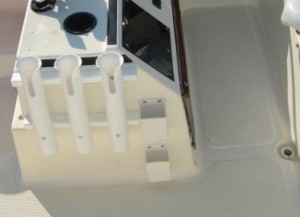
Drain conduit forward of bench seat
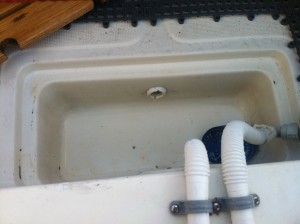 The sump basin looking toward the bow. The hole is the conduit that drains the deck area forward of the bench seat. The sump basin looking toward the bow. The hole is the conduit that drains the deck area forward of the bench seat. |
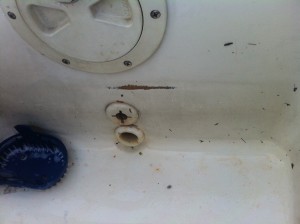 The sump basin looking to the stern. The top hole is the drain for the two rear compartments. The bottom hole is the scupper. The sump basin looking to the stern. The top hole is the drain for the two rear compartments. The bottom hole is the scupper. |
I don’t have a list of the years and models that use this self-bailing system. A 1995 Wahoo! brochure that covers 19 foot and up models makes no mention of it. Yet I’ve spoken to owners of 2100 CCs who said their boats have it. All of the 16.2/1650s I’ve seen have it, as do all of the 1750 Offshores I’ve seen.
While the self-bailing system may have been forward-thinking, in practice there are a number of issues with the design:
Different owners deal with the issues presented by the deck drain system in different ways, depending on their their comfort-level with the original design and whether or not they keep their boat in the water. Some options:
Solution 1 – Use it as is (no modifications): This could work fine if you 1) Don’t store your boat in the water, and 2) Don’t mind getting your feet wet. This was the original design for the boat. In theory it should work even if you DO store your boat in the water. However few owners I’ve spoken to choose this route, regardless of where they keep their boat.
Solution 2 – Install a one-way scupper adapter. This is a flap that allows water to exit the scupper but not enter it. This solution could work fine if you 1) Don’t store your boat in the water, and 2) Don’t want your feet wet. The one-way adapter is installed on the exterior side of the scupper and opens to allow water to escape when underway but otherwise prevents water from coming in. This solution won’t work well for boats stored in the water because it won’t allow rain water to escape. Here’s an example of a scupper adapter.
Solution 3 – Plug the scupper when using the boat. This solution could work fine if you 1) Don’t store your boat in the water, and 2) Don’t want your feet wet, and 3) Typically don’t take on more than a few gallons of water topside when using the boat (and for times you do you could always just bail the sump basin). This was how the previous owner of my boat used it. Prior to each launch he installed a plug on the inside end of the scupper (plugging the outside makes even more sense). At the end of the day when the boat was pulled he removed the plug and it stayed out until the next launch.
Solution 4 – Plug the scupper and add a bilge pump to the sump area: This is the approach most Wahoo! owners who keep their boat in the water take. Plug one or even better both ends of the scupper and install a small automatic bilge pump inside the sump basin. This solution should address any above-deck water issues…provided the pump doesn’t fail!
This is not a suggestion to do as I did but a record for what it’s worth. I store my Wahoo! in the water in a slip. Like a lot of owners, I am not comfortable with the self-bailing system. Specifically, I’m not comfortable with the notion of water entering the scupper when the boat is at rest. And I have concerns that it won’t drain properly during rainstorms–all it takes is a leaf blocking the scupper and your boat fills up with water.
So my solution was to plug the scupper and add an automatic bilge pump to the sump basin. To date I’ve just plugged the inside end of the scupper but next season I’ll plug the outside as well. (Why let water into the scupper where it could potentially leak into the hull?) For a bilge pump I installed a Rule Mate 500. That’s actually a lot more pump than the space requires. I chose it mostly because of its low profile (which allows me to keep the wooden lid on the basin) and because its float switch is A) built in (I didn’t want to have to install a separate switch), and B) float driven rather than chip driven (hopefully less drain on the battery).
The hose from the pump I have draining into the splashwell. In order to keep the original Wahoo! teak lid on the sump basin, I would have had to drill a new hole in it (to allow the hose to pass through). But I really hate the idea of permanently altering a part that is no longer available. So I bought some 3/4″ x 3″ oak from my local lumber yard and fashioned my own slatted lid to the sump basin. It looks good and I have no problem drilling holes in it to my heart’s content.
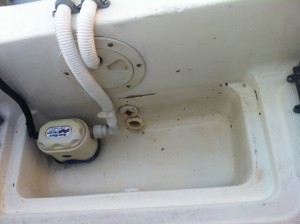 The sump basin of my Wahoo! with a Rule Bilge Mate 500. The pump drains into the splashwell. (The hose you see coming out of the access port connects to a second pump in the boat’s bilge.) The sump basin of my Wahoo! with a Rule Bilge Mate 500. The pump drains into the splashwell. (The hose you see coming out of the access port connects to a second pump in the boat’s bilge.) |
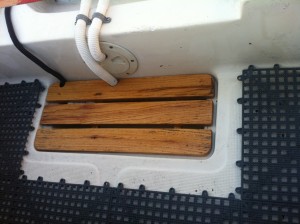 The sump basin with my homemade oak lid. I think it cost me $5 to make. The sump basin with my homemade oak lid. I think it cost me $5 to make. |
So that’s a pass at explaining the Wahoo! self-bailing deck drain. It doesn’t answer everything yet. For example, I’d like to understand why the sump basin scupper was designed to be below the water line. Was that the only place it could go? Or was there a specific advantage to placing it there? Again, if you have questions, thoughts, information, or corrections please share them with your fellow Wahoo! owners.
Here are a few links to online discussions where you might find more info:
Next up: an attempt to explain the Wahoo! below deck drain system (a.k.a., “And here I lost my mind” 🙂 ).
You must be logged in to post a comment.
Thank You for providing a website for Wahoo owners and all the great info and insight you’re providing. The piece on the deck draining system was particularly helpful…..who knew the scuppers were meant to sit below the waterline? Initially thought it was because of the weight of the 70hp four stroke. I never trusted it either and I too plugged the scuppers from the basin outflow. Going into my second season with the boat I’m adding the pump in the basin as well. Thanks again!!!
All the Best
-Eric
Thanks Eric! Appreciate the kind words.
Just picked up a 1989 1650 Dual Console and this is the first article I read. Great post on an important topic for sure. Thanks for the time it took you to write all of this down. I am very interested in your below deck drainage post. Any idea where I can find a mooring cover and cover braces for my new girl?
Sully
Hey gang – 18.5 sportfish owner here. I am getting water in the bilge and trying to plug all external scuppers/drains to see if I can narrow it down to one source.
What are people using to plug the deck drainage tube above the hull drainage screw? Is this 1 1/4″. I know the scuppers are 1″.
Thanks!
Hi Mike, welcome aboard. I use the standard one inch twist-to-tighten drain plug. As mentioned in the article, there are a lot of ways for water to get into the hull. Plus if you keep your boat in the water some water in the hull should always be expected due to condensation.
Monitor to see if the water you’re finding in the hull is worse after a rainstorm or deck hose down. If so, that would suggest either your fittings or holes in the deck you have not found are an issue. Just the other day a close inspection of the rear battery compartment on my Wahoo! turned up two holes previous owners had drilled in the beck floor that would put water into the hull bilge.
Hi All – Have been on salt water my whole life (57) and picked up a 1990 1650 winter of 2010-11 as an “island hopper project” for $2000. Took a bit of elbow grease and time but she;s a “looker” now. I had never heard of the Wahoo but was very familiar with Boston Whaler. This is a great little boat!!
I wanted to thank the creator of this site and other contributors for all the information contained here. The information found here is very helpful and time saving. My Wahoo is usually on a trailer at my house but right now is on a mooring at “camp”. Recent heavy rain proved a flaw in my mooring cover and I ended up with water in the boat. Very easy to get rid of the water “on deck”. I was quite surprised to find the bilge full, too! After reading this site I will check for screw holes, access plates and cable access ports this weekend. I was able to pump the below deck water out and readjust the mooring cover for good runoff but still want to take care of the below deck water.
Final point …. this site gave me a bunch of possible answers to my problem!! We’re heading to camp tonight and I’ll be working on this over the weekend.
Thanks again. I’d love to post some before and after pics of this boat but don’t understand how to do that on this site.
Steve in Maine
PS Had this baby out on the ocean in November this past year … airborne twice … and she handled incredibly!
Great info and well written article. I keep my 16 ft 88 wahoo in the water and have had same issue w/water in the bilge. Problem solved when I installed a bilge pump in the bilge rather than in rear compartment. Water still fills up the back compartment after heavy rain, it drains completely underway then I plug it because I don’t want water in the boat. I’m mostly in the backbay so not a lot of opportunities to take on much water via a rogue wave. This winter I’m going to pull her out and dry the boat completely. I’m thinking the foam in the hull has got to be wet atleast a bit from water previously in bilge. After I dry it out I have a feeling she will sit higher on the water and the rear compartment won’t fill up as much. She’ll run lighter and faster too!!! Thanks again
i just purchased my second hoo..1994 1850 offshore cc.
i was wondering has anyone found a place to purchace replacement wahoo hull decals. i need the black and silver ones?? not the teal colered ones. thanks.
Hi tunakahuna. Welcome aboard. You can get the dark blue/silver the blue/grey decals from Vinyl Approach. Read more here: http://wahoo.seatoad.net/wahoo-parts/replacement-wahoo-decals.htm decals from Vinyl Approach. Read more here: http://wahoo.seatoad.net/wahoo-parts/replacement-wahoo-decals.htm
thank you i ordered the black ones.
my next question is about the livewell in the rear hatch. it seams to be plumbed in to only recirculate the water and not draw sea water into th livewell. this does not make too munh sense. it seams that i have to fill the well up with a pail then it will recirc.
all plumbing looks to be original. why would the factory not plum in a sea cock to pump sea water in?????
Hey great site, we have a 16.2 with the same problem, water in the bildge. Narrowed it down to the tee in front of the bench we are thinking of eliminating the tee and installing a tube between the fuel tank and the underseat compartment as low as possible to go from the front to the back of the bench, glassing over the 3 wholes one in anchor locker, two the tee, and three the sea chest whole. The anchor locker has a pretty good seal so we are not worried about water in there. Does anyone know where to get the rub rail pieces around the transom.
Dave, interesting you should mention the drain conduit in front of the bench seat. Last summer I was able to narrow that area down as a major source (perhaps THE major) source of water in the bilge. In testing I corked that drain hole and poured a few gallons of water into the area. Within a few minutes the water would be gone…drained down into the bilge. So I LifeCaulked all the water around the base of the drain where it meets the deck, thinking it must be a loose fit. But water poured into the area still drains into the bilge. Which so far has left me stumped. There are no obvious holes or cracks in the vicinity, but for sure water is getting into the bilge from that location.
Hi new to site. Buying first boat, and found an 87 16.2 in good shape and for a fair price. My question is whether I will be able to fish this boat in the LI Sound? I am a safe person and looking to do fluke and black fishing not far off shore. I know traffic can be busy in the sound. Any experience or advice. The 16.2 is a nice looking boat!